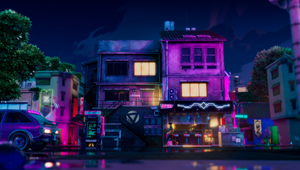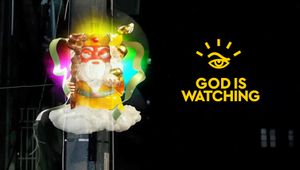
Why Pantone’s Living Coral Has Got Me All Blue Iris in the Face

Working as a designer for nearly a decade, Pantone’s Color of the Year is one of those little birthday moments where I wipe the slate clean and allow my two-X-chromosome eyes to let a new array of colours into my home and wardrobe.
We gather around at work and have a hue coo. We try and recite the last few years. “Ultra Violet was cool, but Marsala looks muddy on the web”, I say. We discuss Rose Quartz. None of us remember that they paired it with Serenity, but we do remember the massive impact of the launch of the Rose Gold iPhone.
“It’s Living Coral!” a designer shouts.
We huddle around and we 'oh' and 'ah' for a few seconds. Coral is a bad ass colour. A colour that took centre stage on my own wedding day in our roses. I feel a flush of excitement.
Then my heart sinks to the bottom of our bleached coral-filled seas.
“Hang on a sec. Did you say Living Coral?!”

I begin to panic as I see a Finding Nemo-style hype reel of a fish in crystal clear waters, swimming around a healthy cluster of coral. I calm myself and frantically search for recognition that Pantone has acknowledged the huge threat our coral reefs face.
Nothing.
Instead, I find a lofty and naively optimistic monologue about how this colour symbolises what the world needs: “Living Coral welcomes and encourages lighthearted activity” and “displays a lively presence within social media”.
Right.
“Representing the fusion of modern life, PANTONE Living Coral is a nurturing color that appears in our natural surroundings”.
That’s strange. I was under the impression this colour was rapidly disappearing from our natural surroundings.
I huffed my way around our studio and offloaded my anger until I went Blue Iris in the face. I sent an angry Tweet to Pantone (hashtag livid) and waited for them to respond.
But they didn’t.
Tumbleseaweed descended across the internet until, a few days later, I saw the first hint of a statement from Pantone in a Gizmodo article about why we should ‘Stop Hating On Pantone's New Colour Of The Year’.
In a statement to Gizmodo, the company said "[w]e were inspired by the natural, colourful diversity of our oceans, and while Pantone is not an environmental organisation, we are aware of the environmental concerns surrounding the dire state of coral reefs and marine life."
Hold up.
You don’t have to be an environmental organisation to drive social change, Pantone.
You have significant reach to designers in their thousands. It's the stories that you tell, not the product that you make, that define who you are – and we all have a responsibility to write the history for design standards.
And being 'aware' is simply not good enough.
Are you aware that every year you could be inspiring designers to use your colours in projects that are crafted with purpose, creating meaningful products and experiences that have an impact?
Are you aware that coral reefs are found in 109 countries and significant reef degradation has occurred in 93? Put that on the tag of your coral-coloured cushion, designers. Use it as an opportunity to create awareness, elevate the conversation, own the positioning and watch the donations flood in.
Unfortunately, this isn’t the first time Pantone has been aware of a conversation and shown a distinct lack of understanding around what that conversation should be about.
In 2015, Leatrice Eiseman, the executive director of the Pantone Color Institute since 1985, said: “The most exciting thing about the Color of the Year is that it starts conversations… [w]e look for how people express themselves using that color… Then it becomes about: why does this shade couple so well with Radiant Orchid? … It’s the discussion beyond [Radiant Orchid] that becomes the conversation about the color.”
Granted this answer was given five years ago, but it gives the impression that Pantone is content for the conversation to limit itself to design trends and consumerism, leaving social and cultural change out of the equation.
I begin to wonder, if “the most exciting part about the Color of the Year is that it starts conversations,” why was my tweet met with silence?
I trawled reactions on social to check if I was alone. And I wasn’t.
@kellylyons24 It's millennial pink for the climate change denier.
I felt somewhat vindicated, but a handful of tweets wasn’t enough to gauge how the rest of the world received the news, so I asked our director of analytics to look into the data behind this socially irresponsible faux pas.
In the months leading up to the release of the new colour, sentiment towards Pantone was incredibly high, with up to 83% of comments being categorised as positive.
However, post release, negative sentiment increased from an average of 10% to as high as 35%, while positive sentiment dropped below 10%.
In Australia, where we hold lots of love for our Great Barrier Reef, the week of the colour launch saw negative sentiment soar to a staggering 47%.
Have those negative sentiments towards Pantone been answered? Absolutely not. And it doesn’t make for much of a conversation if you ask me.
So, how am I going to live with this colour popping up all over my Pinterest feed in 2019?
First, I will use colour in purposeful ways. I will commit to finding missions and means that make way for meaningful change, keeping the impact of my actions on the history of our industry and our planet in mind.
Then, I’ll help Pantone out by providing you all with what they couldn’t: a pathway to act so that we can make these aspirations of colourful coral-filled seas a reality.
No need to write back, Pantone. I’ve got this.
Emma Gough is art director at Digitas Australia












